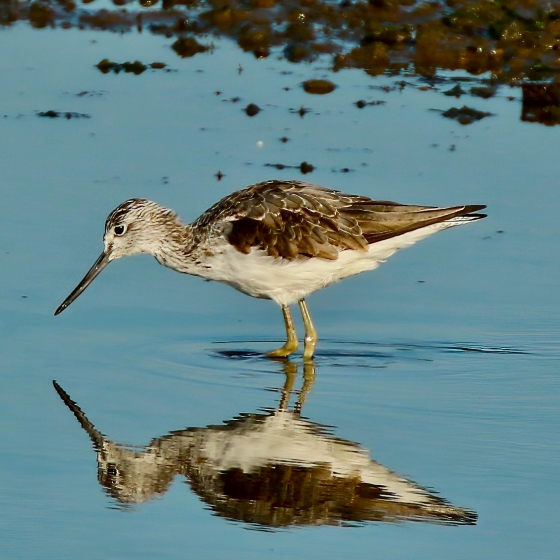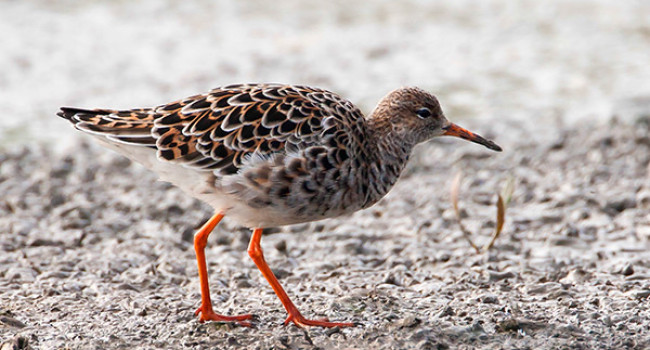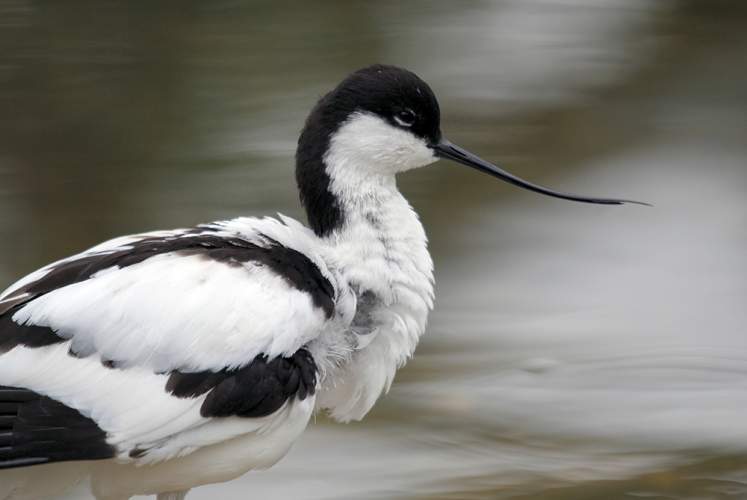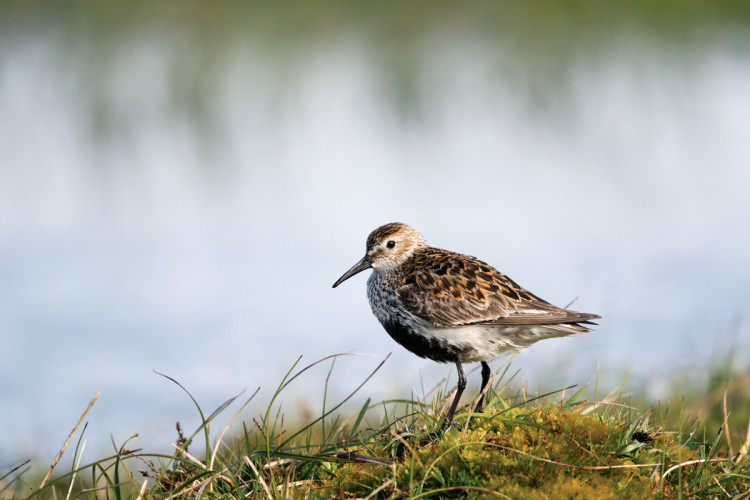Greenshank
Tringa nebularia (Gunnerus, 1767)
GK
 GRESH
GRESH  5480
5480

Family: Charadriiformes > Scolopacidae

This large, lanky wader is most often picked up in wetlands on autumn passage by its distinctive three-note call.
Reports to BirdTrack peak from mid-July to late-September, as individuals migrate south to their wintering grounds in the west of Africa. At this time of year, Greenshank can be found in both coastal and freshwater wetlands, but in the breeding season this is very much a bird of remote moorland, with breeding records confined to the Highlands and islands of Scotland.
Much is known about Greenshank breeding behaviour thanks to a classic study by Desmond Nethersole-Thompson, which was carried out in the “Flow Country” of northern Scotland. Territories usually include a large rock or dead tree as song-post.
Identification
Greenshank identification is sometimes difficult. The following article may help when identifying Greenshank.
Identifying Ruff

Ruff, with their variable size and plumage, often present identification issues. However, by learning how to recognise Ruff in their various guises through this video, you’ll be able to pick them out with confidence, and have a great reference point for identifying other similar-looking waders.
- 1 of 2
- next ›
SONGS AND CALLS
Listen to example recordings of the main vocalisations of Greenshank, provided by xeno-canto contributors.
Other
Call
Song
Develop your bird ID skills with our training courses
Our interactive online courses are a great way to develop your bird identification skills, whether you're new to the hobby or a competent birder looking to hone your abilities.
Browse training coursesStatus and Trends
Population size and trends and patterns of distribution based on BTO surveys and atlases with data collected by BTO volunteers.
CONSERVATION STATUS
This species can be found on the following statutory and conservation listings and schedules.
POPULATION CHANGE
Greenshank breeds in the far north and west of Scotland where it is difficult to survey. The only national survey was made over 20 years ago and came up with a population estimate of 1,080 breeding pairs (Hancock et al. 1997). Hence the status and long-term trend is unclear. The breeding range in the 2008–11 Breeding Atlas was similar to that in 1968–72 with a very slight increase of 2% in the number of occupied squares (Balmer et al. 2013).
| UK winter population |
+100% increase (1995/96 to 2020/21)  |
DISTRIBUTION
Breeding Greenshanks are largely restricted to the bogs and moors of the northwest Highlands and Hebridean islands, with the highest densities in Sutherland, Wester Ross, Lewis, Harris and North Uist. Most wintering bird are associated with large estuary complexes throughout the coasts of Britain & Ireland. Densities are highest in the west, especially in Ireland and parts of western Scotland.
Occupied 10-km squares in UK
| No. occupied in breeding season | 257 |
| % occupied in breeding season | 8.5 |
| No. occupied in winter | 427 |
| % occupied in winter | 14 |
European Distribution Map
DISTRIBUTION CHANGE
There have been minor breeding-range expansions, mostly on Shetland, Lewis, North Uist and in West Inverness. Losses are most evident in the eastern fringes of the range, particularly in Badenoch and Strathspey.
Change in occupied 10-km squares in the UK
| % change in range in breeding season (1968–72 to 2008–11) | +1.6% |
| % change in range in winter (1981–84 to 2007–11) | +44.8% |
SEASONALITY
Greenshanks are recorded throughout the year, though most likely during autumn passage.

Movement
Information about movement and migration based on online bird portals (e.g. BirdTrack), Ringing schemes and tracking studies.
An overview of year-round movements for the whole of Europe can be seen on the EuroBirdPortal viewer.
RINGING RECOVERIES
View a summary of recoveries in the Online Ringing Report.
Foreign locations of birds ringed or recovered in Britain & Ireland

Biology
Lifecycle and body size information about Greenshank, including statistics on nesting, eggs and lifespan based on BTO ringing and nest recording data.
SURVIVAL & LONGEVITY
View number ringed each year in the Online Ringing Report
Maximum Age from Ringing 
|
16 years 0 months 3 days (set in 2001) 
|
BIOMETRICS
Wing Length 
|
Adults | 192.6±5.8 | Range 183–202mm, N=83 |
| Juveniles | 191.3±5 | Range 183-200mm, N=139 |
Body Weight 
|
Adults | 199±27.93 | Range 150–241g, N=76 |
| Juveniles | 180±33.2235 | Range 133–246g, N=120 |
Feather measurements and photos on featherbase 
CODES & CLASSIFICATION
Ring size 
|
D2 |
Field Codes 
|
2-letter: GK | 5-letter code: GRESH | Euring: 5480 |
For information in another language (where available) click on a linked name
Research
Interpretation and scientific publications about Greenshank from BTO scientists.
CAUSES AND SOLUTIONS
Causes of change
The current trend is uncertain and hence drivers of change are also unclear. Some local declines may be linked to habitat degradation and afforestation (Hancock et al. 1997). However, Watson & Francis (2012) suggested a number of possible causes to explain local losses in Deeside including acidic deposition, overgrazing and trampling, disturbance, predation and reforestation. Further research is needed therefore to confirm whether or not any of these possible causes contribute towards population trends.
PUBLICATIONS (2)

Consequences of population change for local abundance and site occupancy of wintering waterbirds
Wavering Waterbirds
Protected sites are assigned based on population statistics for vulnerable and endangered species. This new study using WeBS data shows that changes in population size can affect local abundance, and thus influence whether or not key targets are met for site protection.

Sensitivity mapping for breeding waders in Britain: towards producing zonal maps to guide wader conservation, forest expansion and other land-use changes. Report with specific data for Northumberland and north-east Cumbria
Sensitivity mapping for breeding waders
Models to be used towards the development of tools to guide, inform and minimise conflict between wader conservation and forest expansion.
Links to more information from ConservationEvidence.com
Would you like to search for another species?














Share this page